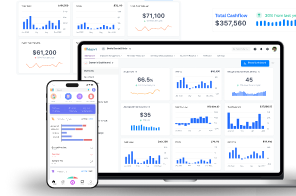Companies often have multiple subsidiaries or entities – and it’s probably more common than you think. Did you know Super 8 hotels are owned by Wyndham Hotel & Resorts? Perhaps you’re aware that Hilton is the parent company of hotels such as Waldorf Astoria and DoubleTree? Although these businesses function independently, they are owned by parent companies that hold a 50% or greater controlling interest.
Businesses with one or more subsidiaries perform inter-entity transactions to record various activities across companies. Intercompany transactions are critical in consolidated financial statements as they help business owners facilitate decision making and long-term strategy.
What are Intercompany Transfers?
Intercompany transactions occur when two entities under the same parent company engage in financial or asset sharing activities. Viewing intercompany transfers on consolidated financial statements helps the parent company see the overall economic performance of all subsidiaries and entities.
The three types of intercompany transactions include:
- Downstream transactions: flows down from the parent company to a subsidiary. Let’s say Hilton Hotels sells furniture to Embassy Suites. The transaction is shown on Hilton Hotel’s balance sheet as cash received and furniture sold. Embassy Suites, on the other hand, shows furniture received and cash paid out.
- Upstream transactions: flows up from the subsidiary to the parent company. Let’s say a Sheraton hotel sells 10,000 daybeds to Marriott. Sheraton ends up recording the consequent transaction as cash received and furniture sold. Marriott, on the other hand, will show furniture received and cash paid out.
- Lateral transactions: occurs between two subsidiary companies that fall under the same organization. Holiday Inn provides consulting services to Staybridge Suites. Holiday Inn’s accounting ledger would show a lateral transaction with one side recording consulting service fees and the other recording accounts payable.
Each of these types of intercompany transactions take place within the same parent company and are recorded on group-level financial statements. The most common types of intercompany transactions are: sales, loans and advances given, interest paid, and depreciation.
The Importance of Inter-Entity Transfers
Inter-entity transfers allow businesses to move funds from one business to another. Sometimes, transfers occur when funds are transferred from one entity to another if the other does not possess sufficient funding. Accountants review all intercompany transfers at the close of the fiscal year and balance out all receivables and payables. However, reconciling and balancing intercompany accounts can be challenging due to lost invoices, invoice discrepancies, exchange rate differences, and cash in transit. Each and every detail must be appropriately accounted for in financial statements to mitigate the risk of theft and fraud.
Some common intercompany accounting mistakes that can affect the financial statements include:
- Accounts receivables are recorded at one company, but the subsequent accounts payable entry is not made in the ledger of the other company.
- Sales and purchase transactions are recorded in different financial periods.
- Expenses incurred by one company not recorded in the books of both the parent and subsidiary.
- Assets, liabilities, income and expenses within a group are not properly adjusted which affects the parent company’s financial reports.
Some businesses are made up of several different types of entities. Perhaps you’re a restaurant owner and a hotel owner. Managing the accounting for each of these businesses can be challenging. Docyt makes the process easier by automating accounting and intercompany transfers.
Automate Intercompany Transfers
Docyt helps business owners streamline inter-entity transfers by automating data collection, automating complex journal entries, and continuously updating the profit and loss statement and balance sheet of each business. Docyt also standardizes accounting processes across entities to increase financial report accuracy and efficiency.
If you’re looking for one accounting solution for all your businesses, Docyt has you covered. Book a demo to learn more today.




